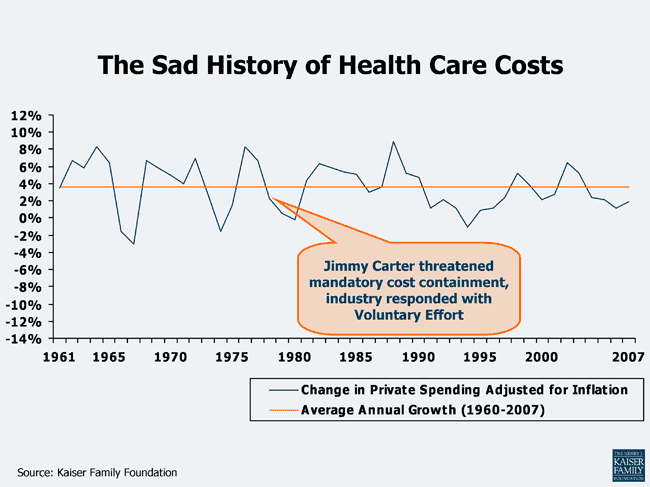Pulling it Together: The Health Care Industry’s Second Voluntary Effort
The announcement that health care industry groups plan to put on the table voluntarily a package of proposals to shave $2 trillion off the rate of increase in health spending over the next ten years immediately conjures up the image of the Voluntary Effort or VE launched with similar fanfare in the Carter administration. Back then the industry used the VE to fend off Jimmy Carter’s efforts to aggressively control the costs of hospital care by offering to do it themselves on a voluntary basis. The VE helped defeat Carter’s plan and actually worked for a few years. As the chart shows, the rate of increase in health care costs fell for a few years, but then spiked again, and resumed its upward trajectory. This has been the history of efforts to control health costs; we sometimes achieve temporary successes, but higher rates of increases, at least in the past, have always returned.
Ever since the Carter years (I worked for Jimmy Carter in what was then the Health Care Financing Administration) the VE has been viewed in health policy circles as something of a farce; a president diverted by an industry trying to fend off cost containment actions it saw as more harmful to its bottom line by promising to regulate itself. While today’s voluntary actions by health care groups are not intended to block action on health reform legislation like the earlier VE was—far from it, the industry is at the table in an unprecedented way—they do underscore how the prospect of broader action by a president and congress, including specific ideas industry groups don’t like such as a public plan option, can sometimes motivate an industry to do more on its own than it would otherwise do.

But the new announcement need not be viewed cynically. The President was very clear in his remarks that the private effort is a parallel one, not to be confused with the challenge of designing and paying for health reform legislation, scored by the CBO, on Capitol Hill. The new move by the health care industry groups also reflects a very public recognition on their part that the rate of growth in health spending needs to be reduced, even if the goals they announced may not prove fully achievable, either because national associations cannot deliver their members or expected savings do not materialize. The recognition by the industry itself that current rates of increase in health spending are unsustainable is a good thing and will provide cover for other efforts to reduce health spending not just this one.
The bigger test will come soon: once there is health reform legislation on the table will the industry remain supportive or will they revert to form and protect their bottom line? At that point, the health reform debate will enter a new and critical phase. If the industry is still at the table then, that could truly be a game changer.
